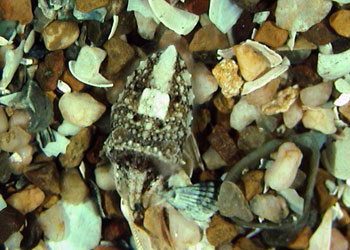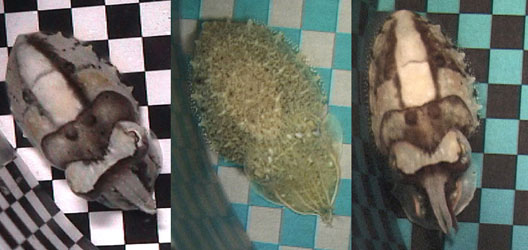 |
Cuttlefish Masters of Disguise Despite Colorblindness
April 10, 2006
Cuttlefish are wizards of camouflage. Adept at blending in with their surroundings, cuttlefish are known to have a diverse range of body patterns and can switch between them almost instantaneously. New research from MBL Marine Resources scientists, to appear in the May 2006 issue of the journal Vision Research, confirms that while these masters of disguise change their appearance based on visual cues, they do so while being completely colorblind.
While previous research has reported cuttlefish colorblindness, MBL Research Associate Lydia Mäthger and her colleagues in Roger Hanlon's laboratory approached the problem in more depth and with a new behavioral assay. The researchers tested cuttlefish (Sepia officinalis) color perception through observing the animal's behavioral response to a series of checkerboard patterned substrates of various colors and brightnesses.
They found that the animals did not respond to the checkerboard pattern when placed on substrates whose color intensities were matched to the Sepia visual system, suggesting that these checkerboards appeared to their eyes as uniform backgrounds. However, their results showed that cuttlefish were able to detect contrast differences of at least 15%, which Mäthger and her colleagues suspect might be a critical factor in uncovering what determines camouflage patterning in cuttlefish.
Despite these results, the vexing question of how cuttlefish master the task of camouflage in low-contrast, color-rich environments such as those found at shallow depths of water, remains to be answered. Mäthger and her colleagues are currently looking at cuttlefish contrast sensitivity in more detail. "Our result that cuttlefish are able to detect contrast differences of at least 15%, is only an upper limit," says Mäthger. "It's certainly not the contrast threshold, which we would like to know. It seems that cuttlefish camouflage themselves by matching intensities of objects in the environment and we're collecting data to test see whether this is really the case."
In addition to looking at contrast between different objects, Mäthger and her colleagues are testing a variety of other optical clues, in particular, cuttlefish perception of object edges, brightness, and sizes of objects.
Cuttlefish are cephalopods, relatives of octopuses and squid, and are found in all marine habitats worldwide; they are particularly abundant around coral reefs and temperate rock reefs in which the visual habitat is richly varied. Cephalopods can change their appearance with a speed and diversity unparalleled in the animal kingdom. Some squids, octopuses, and cuttlefish can show 30-50 different appearances. Their sophisticated neural control of the skin make cuttlefish an excellent model for studying camouflage.
Please click on thumbnail for full-sized image:

Cuttlefish are wizards of camouflage. Adept at blending in with their surroundings, cuttlefish are known to have a diverse range of body patterns and can switch between them almost instantaneously.

Mäthger and her colleagues tested cuttlefish color perception through observing the animal’s behavioral response to a series of checkerboard patterned substrates of various colors and brightnesses. This series of images shows that cuttlefish exhibit the same disruptive pattern when they sit on a high contrast black and white or black and green checkerboard, but when on a low contrast (to their eyes) grey and green background, their body pattern remains uniform, suggesting that they can't tell the two shades apart.
Photos and video courtesy of Lydia Mäthger, MBL
Resources:
Download the complete article (PDF)
View the video (Quicktime)
Links:
Lydia Mäthger's Website
Roger Hanlon's Website
Tree of Life - Cephalopod Page
Past MBL Articles on cuttlefish:
New Research Shows in the Animal World, it Pays to be an Imposter
Cuttlefish Tricks
|